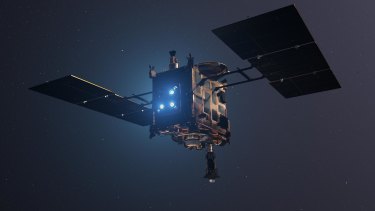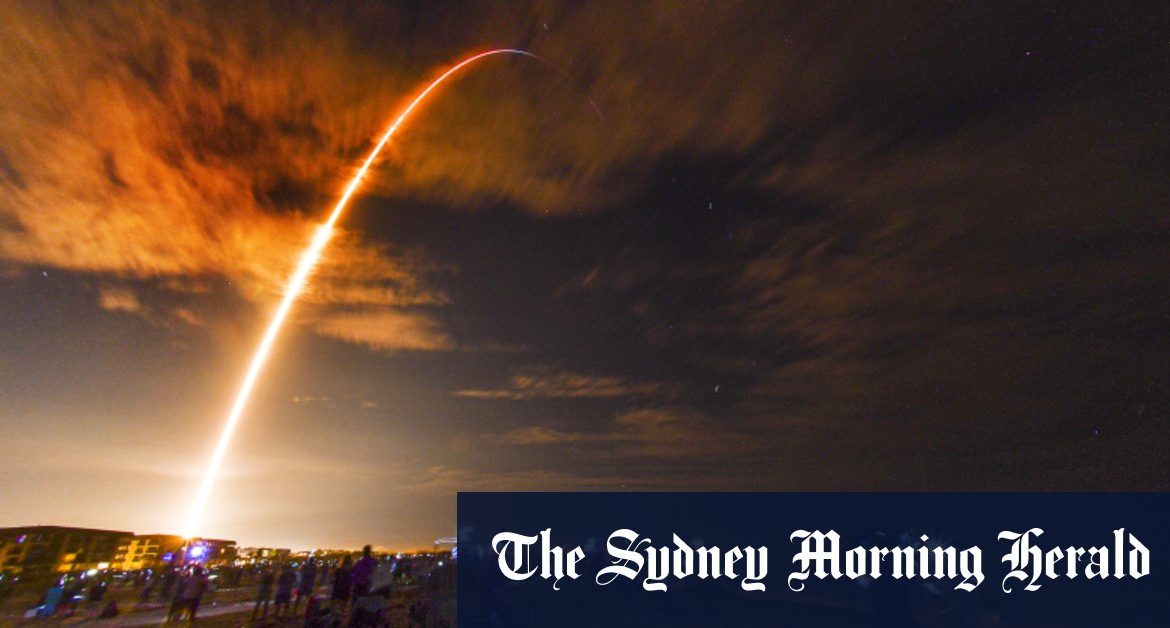“2021 promises to be as much of a space exploration bright spot, perhaps even more,” said Scott Hubbard, NASA’s former “Mars Czar” now teaching at Stanford University.
Although the coronavirus pandemic complicated space operations around the globe in 2020, most high-priority missions remained on track, led by the US, China and the United Arab Emirates in a stampede to Mars in July.
NASA astronauts, from left, Shannon Walker, Victor Glover, and Michael Hopkins and Japan Aerospace Exploration Agency astronaut Soichi Noguchi.Credit:AP
The UAE’s first interplanetary spacecraft, an orbiter, will scrutinise the Martian atmosphere. NASA’s Perseverance rover is set to land February 18 at an ancient river delta and lakebed where microscopic life may have once flourished. The rover will drill into the dry crust, collecting samples for eventual return to Earth.
China’s orbiter-rover duo Tianwen-1 — quest for heavenly truth — also will hunt for signs of bygone life.
The European and Russian space agencies skipped the 2020 Mars launch window, their life-sniffing Mars rover grounded until 2022 because of technical issues and COVID-19 restrictions.
China also set its sights on the moon in 2020, landing and then launching off the lunar surface in December with the first moon rocks collected for return to Earth since the 1970s.
A view from SpaceX’s Cargo Dragon spacecraft as it approaches the International Space Station.Credit:SpaceX
Japan brought back pieces of asteroid Ryugu — its second asteroid batch in a decade — with the capsule landing in South Australia. More asteroid samples are on the way: NASA’s Osiris-Rex spacecraft vacuumed up handfuls of gravel from asteroid Bennu in October for return in 2023.
Elon Musk’s SpaceX, meanwhile, was buzzing in 2020. In May, it became the first private company to put people into orbit, an achievement previously claimed by just three global superpowers. The two test pilots were the first NASA astronauts to fly a new brand of spaceship in almost 40 years and the first to blast off from Florida since the shuttle program ended in 2011.

An artist’s rendering of JAXA’s Hayabusa-2 firing its ion thrusters in space.
In November, four more astronauts rode a SpaceX Dragon capsule to the International Space Station. Three weeks later, SpaceX launched its biggest cargo shipment yet to the space station for NASA.
“This is an impressive achievement which Americans should be proud of,” astronaut-turned-senator Mark Kelly said of the Dragon capsule double-header.
Until the SpaceX flights, Russia’s three-person Soyuz capsules were the only way to get astronauts to the space station once NASA’s shuttles shut down.
NASA’s other hired crew transporter, Boeing, is scrambling to get its Starliner capsule back in action after a software-spoiled test flight in December 2019. The do-over — again with no one on board — is targeted for spring. If the repairs work and the capsule finally reaches the space station, the first Starliner astronauts could be flying by summer.
SpaceX Starship rocket exploded after performing a flip manoeuvre.Credit:SpaceX
Musk capped the year with a stratospheric test flight of Starship, the rocketship he’s building to carry people to the moon and Mars. The December 9 demo went better than anyone imagined until a fiery explosion at touchdown. Even so, Musk was ecstatic.
At the same time, SpaceX is expanding its Dragon-riding clientele. Late next year, SpaceX expects to launch the first privately financed Dragon flight in a deal arranged by Houston-based Axiom Space.
Axiom’s Michael Lopez-Alegria, an ex-NASA astronaut and former president of the Commercial Spaceflight Federation, will accompany Israeli businessman Eytan Stibbe and two other paying customers to the space station. Stibbe, a former fighter pilot, was a close friend of Israel’s first astronaut, Ilan Ramon, who died aboard space shuttle Columbia in 2003.
Will Tom Cruise be joining them? The actor was in talks with NASA this year about filming a movie at the space station.
“This is the true beginning of private spaceflight and will get the ball rolling toward multiple private missions to orbit per year,” Lopez-Alegria said in an email. “I’ve been preaching for almost a decade that commercial human spaceflight is the next giant leap.”
Two other space-travel companies — Jeff Bezos’ Blue Origin and Richard Branson’s Virgin Galactic — are still conducting test flights and have yet to set firm dates for launching customers on short flights to the edge of space and back.
NASA is still targeting a November debut of its new moon rocket, the Space Launch System, with an Orion capsule that will launch without a crew. The Trump administration had set a 2024 deadline for the first moon landing by astronauts since NASA’s Apollo program a half-century ago. Just this month, NASA introduced the 18 astronauts who will train for the moon program named for Artemis, the mythological twin sister of Apollo.
It remains to be seen how President-elect Joe Biden might alter the lunar-landing program.
“Whatever else can be said about the four years of the Trump administration, they have been positive for the US civilian space program,” noted John Logsdon, professor emeritus at George Washington University’s Space Policy Institute. “No prior major programs were cancelled, the human exploration program was given clear direction, and funding for existing programs was increased.”
“This is a legacy that the Biden administration can build on, so that in future years there can be a continued string of successes.”
AP
Most Viewed in World
Loading







